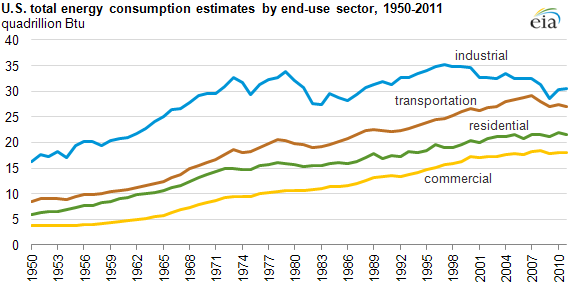Consumption & Efficiency
-
New 2010 Manufacturing Energy Consumption Survey (MECS) Data Released ›
-
Two perspectives on household electricity use ›

Industrial and transportation sectors lead energy use by sector ›
Texas is the top energy consuming state ›
Energy In Brief
What are the major sources and users of energy in the United States?
The major energy sources in the United States are petroleum (oil), natural gas, coal, nuclear, and renewable energy. The major users are residential and commercial buildings, industry, transportation, and electric power generators. The pattern of fuel use varies widely by sector. For example, oil provides 93% of the energy used for transportation, but only about 1% of the energy used to generate electric power.
How can we compare or add up our energy consumption?
To compare or aggregate energy consumption across different energy sources like oil, natural gas, and electricity, we must use a common unit of measure. This is similar to calculating your food energy intake by adding up the calories in whatever you eat.
Energy Explained
How We Use Energy
The United States is a highly developed and industrialized society. We use a lot of energy in our homes, in businesses, in industry, and for personal travel and transporting goods.
Features
 Manufacturing energy consumption data show large reductions in both manufacturing energy use and the energy intensity of manufacturing activity between 2002 and 2010
Manufacturing energy consumption data show large reductions in both manufacturing energy use and the energy intensity of manufacturing activity between 2002 and 2010Release Date: March 19, 2013
Total energy consumption in the manufacturing sector decreased by 17 percent from 2002 to 2010 (Figure 1), according to new 2010 MECS data.
 Watch: Keeping our Homes Warm
Watch: Keeping our Homes WarmReleased November 2, 2012
A video about changes in home heating in the United States.
 Annual Energy Review Consumption Statistics
Annual Energy Review Consumption StatisticsReleased September 27, 2012
A report of annual energy statistics through 2011. Included are data for energy consumption by source and by sector.
 Energy Characteristics and Energy Consumed in Large Hospital Buildings in the United States in 2007
Energy Characteristics and Energy Consumed in Large Hospital Buildings in the United States in 2007 Release Date: August 17, 2012
Includes estimates of building characteristics, energy sources, end uses, energy management features, energy consumption, and water consumption for hospital buildings greater than 200,000 square feet.
 RECS data show decreased energy consumption per household
RECS data show decreased energy consumption per householdRelease Date: June 6, 2012
Total United States energy consumption in homes has remained relatively stable for many years as increased energy efficiency has offset the increase in the number and average size of housing units, according to the from the Residential Energy Consumption Survey (RECS).
End-use consumption
data & surveys
Residential Energy Consumption (RECS)
Commercial Building Energy Consumption (CBECS)
Sector totals:
Consumption and efficiency
analysis & projections
Annual Energy Outlook 2013
Reference Case:




